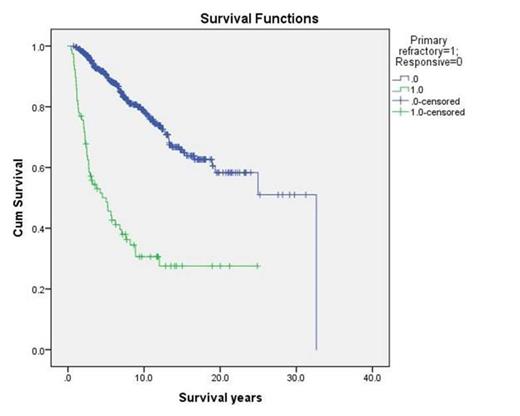Abstract
BACKGROUND
Follicular lymphoma (FL) is the most common indolent form of non-Hodgkin's lymphoma. However, FL is a heterogeneous disorder and in a proportion of patients, the disease is very resistant to standard frontline therapies. In the current analysis clinical features and outcome to primary treatment were evaluated in a large series of FL patients who were consecutively treated at the Hematology Centers of Bergamo and Torino, Italy between 1976 and 2012. The aim of the study was to define the rate of refractory disease and the long term survival of patients according to response to their primary treatment.
METHODS
Medical records of 597 FL patients were reviewed. In front line therapy, rituximab was employed in 330 patients (55%), front-line high dose therapy with autograft (HDS) was administered in 58 patients (9.7%). Primary refractory disease was defined as full refractoriness (stable or progressive disease) or progressive disease within six months after initial response. Univariate analysis was done for prognostic factors including gender, age at diagnosis (age≤60 and >60 years), histological grade, IPI score (low=0-2 versus high=3-5), bone marrow (BM) involvement, rituximab administration in 1st line treatment, lymphocyte to monocyte ratio at diagnosis (>2.6 vs ≤2.6), presence of primary refractory disease, and the administration of front-line HDS. Cox model was also used for multivariate analysis.
RESULTS: A total of 375 patients (63%) were older than 60 years (range: 18-88) and 49% were males. There were 476 patients (79.7%) with stage III-IV, 286 patients (48%) with BM involvement, 185 (31%) had a high IPI score and 28 patients (5%) presented with high histological grade. Eighty-seven patients (13%) displayed primary refractory disease. At a median follow-up of 8 years, median overall survival (OS) was 25 years for all patients, 32.6 years for responsive patients compared to 5 years for primary refractory patients (p=<0.0001). Among primary refractory patients, those with fully refractory disease had a shorter survival (median OS: 2.7 years) compared to patients with early progressive disease (median OS: 5 years). The strikingly different outcome of primary refractory vs. responsive patients is shown in the Figure 1. A significant prolonged survival was observed in patients who were treated with rituximab in primary therapy. The median OS is not reached for rituximab treated patients compared to 19 years for those who did not receive rituximab. Median OS was 25 years for patients with low IPI and 14.6 years for the high risk group. By univariate analysis, age and BM involvement were also significant prognostic factors for OS. Median OS for patients 60 years old or younger compared to older patients were 32.6 versus 13 years, respectively. The median survival was not reached for patients without BM involvement vs 19 years for patients with BM involvement (p=0.001). By multivariate analysis high IPI, refractory disease and not receiving rituximab in first line regimens were independent negative prognostic factors for OS, as detailed in Table 1.
CONCLUSION: FL patients who display responsive disease to their primary treatment have a very long life expectancy with median survival of 32.6 yrs. Similarly to the aggressive lymphoma subtypes, primary refractory disease is of major concern also for FL. Research studies should be focused on the early identification of primary refractory patients to promptly institute adapted therapy for this unfavorable subgroup, and possibly optimize treatment strategies for patients with high-risk FL.
Multivariate analysis for overall survival
| Parameter . | Hazard Ratio (95% Confidence interval) . | p-value . |
|---|---|---|
| Age (yrs): >60 vs. ≤ 60 | 1.54 (1.5-2.3) | .03 |
| Histologic grade: 1-2 vs 3 | 2.25 (0.5-9.1) | .3 |
| IPI *Score: low (0-2) vs high(3-5) | 0.59 (0.4-0.9) | .009 |
| Primary Refractory: yes vs no | 4.40 (3.0-6.5) | < .0001 |
| Rituximab 1st line: yes vs no | 0.56 (0.4-0.8) | .005 |
| BM# involvement: yes vs no | 1.44 (1.0-2.1) | .06 |
| Parameter . | Hazard Ratio (95% Confidence interval) . | p-value . |
|---|---|---|
| Age (yrs): >60 vs. ≤ 60 | 1.54 (1.5-2.3) | .03 |
| Histologic grade: 1-2 vs 3 | 2.25 (0.5-9.1) | .3 |
| IPI *Score: low (0-2) vs high(3-5) | 0.59 (0.4-0.9) | .009 |
| Primary Refractory: yes vs no | 4.40 (3.0-6.5) | < .0001 |
| Rituximab 1st line: yes vs no | 0.56 (0.4-0.8) | .005 |
| BM# involvement: yes vs no | 1.44 (1.0-2.1) | .06 |
*International prognostic index was used to have a uniform prognostic factors scoring system for patients treated
over the three decades of the survey.
#Bone marrow
Overall Survival in 597 follicular lymphoma patients according to response to primary treatment
Overall Survival in 597 follicular lymphoma patients according to response to primary treatment
No relevant conflicts of interest to declare.
Author notes
Asterisk with author names denotes non-ASH members.


This feature is available to Subscribers Only
Sign In or Create an Account Close Modal